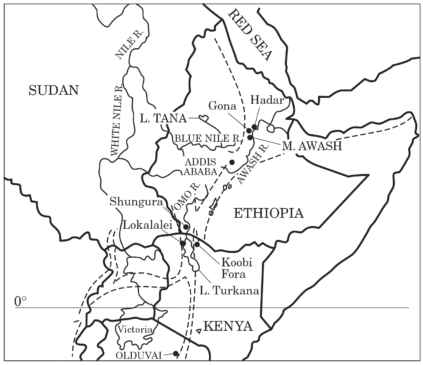“Lucy” Lived Among Close Cousins: Discovery of Foot Fossil Confirms Two Human Ancestor Species Co-Existed
Addis Ababa, ETHIOPIA (Press Release) : An international team of Ethiopian and American scientists conducting paleontological field research in the Woranso-Mille area of the Afar region of Ethiopia has announced the discovery of a 3.4 million-year-old partial foot. The new specimen did not belong to a member of “Lucy’s” species, Australopithecus afarensis, the famous and most-researched early human ancestor. The partial foot was found in an area locally known as Burtele, located in the Mille District of Zone 1 of the Afar Regional State. The discovery and results from the initial analysis of this specimen will be published in the March 29, 2012 issue of the international scientific journal Nature.
 Lead author and Woranso-Mille project team leader Dr. Yohannes Haile-Selassie, Curator and Head of Physical Anthropology at The Cleveland Museum of Natural History, said, “The Burtele partial foot clearly shows that at 3.4 million years ago, Lucy’s species, which walked upright on two legs, was not the only hominin species living in what is now the Afar region of Ethiopia. Her species co-existed with close relatives who were more adept at climbing trees like ‘Ardi’s’ species, Ardipithecus ramidus, which lived 4.4 million years ago.” Lucy’s species lived from 2.9 million years ago to 3.8 million years ago.
Lead author and Woranso-Mille project team leader Dr. Yohannes Haile-Selassie, Curator and Head of Physical Anthropology at The Cleveland Museum of Natural History, said, “The Burtele partial foot clearly shows that at 3.4 million years ago, Lucy’s species, which walked upright on two legs, was not the only hominin species living in what is now the Afar region of Ethiopia. Her species co-existed with close relatives who were more adept at climbing trees like ‘Ardi’s’ species, Ardipithecus ramidus, which lived 4.4 million years ago.” Lucy’s species lived from 2.9 million years ago to 3.8 million years ago.
Scientists have long argued that there was only one pre-human species between 3 and 4 million years ago. The new Burtele partial foot (BRT-VP-2/73) is the first incontrovertible evidence for the presence of at least two pre-human species with different modes of locomotion contemporaneously living in eastern Africa around 3.4 million years ago. While the first digit (big toe) of the foot in Lucy’s species, Australopithecus afarensis, was aligned with the other four digits for human-like bipedal walking, the Burtele foot has an opposable big toe like the earlier Ardipithecus ramidus and was probably a facultative biped when on the ground.
Co-author Dr. Bruce Latimer of Case Western Reserve University said, “It is now clear that the adaptation to terrestrial bipedality was not a single, isolated event. Rather, one group (Lucy’s species) totally relinquished the arboreal habitat and became functionally committed, long-distance ground walkers while another group, represented by the Burtele foot, maintained a climbing foot and stayed, at least part of the time, in the trees. It is now apparent which group succeeded.”
The new partial foot has not yet been assigned to a species although it is similar in some of its morphology to the 4.4 million-year-old Ardipithecus ramidus. “The lack of cranial and dental elements associated with the Burtele foot, and its much younger age, precludes its assignment to Ardipithecus ramidus,” said Haile-Selassie.
 Discovery of the Burtele Partial Foot:
Discovery of the Burtele Partial Foot:
The first piece (proximal half of a fourth metatarsal) was discovered on February 15, 2009, by Stephanie Melillo (project member and former graduate student at Stanford University) eroding out of a sandstone horizon. The remaining half of this element was found on the surface about 10 centimeters from the first piece. Further surface scraping and excavation resulted in the recovery of a total of eight elements of a right foot from one individual. These elements make up the forefoot and include a complete first metatarsal, a complete second metatarsal, the head of a third metatarsal, a complete fourth metatarsal, three proximal phalanges (rays 1, 2, and 4), and one intermediate phalanx (ray 2). The lack of the same element from the same side, placements of the recovery of each element, and preservation of the recovered specimens indicate that they are from a single foot.
Location of the Discovery:
The Burtele foot (BRT-VP-2/73) was found in the Woranso-Mille Paleontological Project study area located in the central Afar region of Ethiopia about 325 miles (520 kilometers) northeast of the capital Addis Ababa and 30 miles (50 kilometers) north of Hadar (“Lucy’s” site). Burtele is the local name for the area where the partial foot was found and it is located in the Mille district, Zone 1 of the Afar Regional State, 27 kilometers east of Mille town on the road to Chifra. This area is inhabited by the Afar people who are semi-nomadic.
Geology and Age Determination:
The Burtele locality, where the partial foot was found, is part of a rift basin in the Afar and has an interesting stratigraphy composed of several rock types. The Burtele partial foot was found eroding out from a silty clay below sandstone, approximately 27 meters stratigraphically above a thin tuff, dated to 3.469 ± 0.008 Myr ago by the 40Ar/39Ar (“Argon-Argon”) method. The dating was conducted at the Berkeley Geochronology Center, Berkeley, California, by project member and co-author Dr. Alan Deino.
An approximate age for the partial foot was estimated using regional sediment accumulation rates in the older Woranso-Mille and younger Hadar areas yielding an age of 3.22 and 3.38 million years ago, respectively. These contrasting ages result from the lower estimated rate of deposition for the Woranso-Mille deposits and higher rate of deposition for the Hadar sediments. The combined rate of deposition from the two areas yields an age between 3.2 and 3.4 million years ago for the Burtele partial foot, more likely closer to the older age.
Dr. Mulugeta Alene, geologist at the Addis Ababa University, project member and co-author of the paper said, “The sedimentation at Burtele appears to show a transition from a claystone at the base to largely ancient soil and cross-bedded sandstone at the top. This can be related to a deposition in a lake-like basin, perennial water body, and delta system, respectively, and the deposition of such variable types of sediments within short period of time is not uncommon, particularly in a rift environment.”
Significance of the Discovery:
1. The Burtele partial foot (BRT-VP-2/73) is the first incontrovertible fossil evidence to show the presence of more than one adaptively separated pre-human species between 3 and 4 Million years ago: Scientists have long argued that there was only one pre-human species at any given time between 3 and 4 million years ago. When the 3.5 million-year-old Kenyanthropus platyops was named from Kenya in 2001, it was suggested by the discoverers that it indicated the presence of more than one species during the late Pliocene. However, some researchers doubted the validity of the species due to the distorted nature of the specimen assigned to the new species. The Burtele foot belongs to a species that does not match the contemporaneous Australopithecus afarensis in its morphology and inferred locomotor adaptations.
2. The Burtele partial foot (BRT-VP-2/73) shows the persistence of Ardipithecus ramidus-like locomotor adaptation into the late Pliocene: At 4.4 million years ago,Ardipithecus ramidus, with its divergent great toe, surprised the scientific community in 2009 by showing that all human ancestors after the split from the common ancestor they shared with chimpanzees did not have modern human-like foot morphology. However, at 3.7 million years ago, Lucy’s species, Australopithecus afarensis, had developed humanlike foot morphology as seen from the fossil foot elements of the species from Hadar, Ethiopia, and footprints from Laetoli, Tanzania. The presence of a species with Ardipithecus ramidus-like locomotor adaptation at 3.4 million years ago indicates that locomotor adaptations during the earlier parts of human evolution were more diverse and such diversity persisted longer than previously thought.
3. The Burtele partial foot (BRT-VP-2/73) generates new information on the foot morphology and metatarsal ratios of the earliest human ancestors: The forefoot (metatarsals and phalanges) of early human ancestors is poorly preserved in the fossil record due to its fragility, predator activity, and various agents in the fossilization process. As a result, metatarsal length ratios are poorly understood for early human ancestors. BRT-VP-2/73 is the first fossil specimen to preserve metatarsals of both the second and fourth digits. Monkeys and Miocene-age apes have a fourth metatarsal longer than the second metatarsal. The Burtele foot is similar to monkeys and some Miocene apes in this ratio. In humans, the second metatarsal is longer than the fourth. This ratio is unknown in Ardipithecus and Australopithecus and hence its significance cannot be accurately assessed although a fourth metatarsal longer than the second is more likely to be the primitive condition for the human lineage.
The Woranso-Mille Project:
The Woranso-Mille Paleontological project conducts field and laboratory work in Ethiopia every year. This multidisciplinary project, initiated in 2004, is led by Dr. Yohannes Haile-Selassie of The Cleveland Museum of Natural History and Dr. Bruce Latimer of Case Western Reserve University, Cleveland, Ohio, USA. Additional co-authors of this research include: Dr. Beverly Saylor of Case Western Reserve University and Dr. Naomi Levin of Johns Hopkins University, Baltimore, Maryland, USA. Participants of the project include scientists from Ethiopia, the United States of America, France, Spain, and Sweden. These scientists specialize in various subdisciplines of geology and paleontology. Graduate and undergraduate students from Ethiopia and the United States of America also participate in the field and laboratory activities of the project.
Support:
The Authority for Research and Conservation of Cultural Heritage (ARCCH) annually issues fieldwork research permit to the Woranso-Mille project. The National Museum of Ethiopia and the Directorate of Collections, Curation, and Laboratory Services of ARCCH provided laboratory research facility and fossil storage space.
Field and laboratory work conducted by the Woranso-Mille project through the years were supported by grants from the National Science Foundation (Physical Anthropology program; BCS-0234320, BCS-0321893, BCS-0542037 and BCS-1124705), The Leakey Foundation, and The National Geographic Society. The first few years of field and laboratory research were also partially supported by the Wenner-Gren Foundation.
Prepared by the Authority for Research and Conservation of Cultural Heritage (ARCCH) & the Woranso-Mille Paleontological Project



